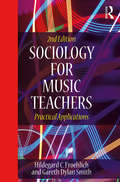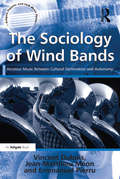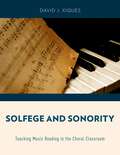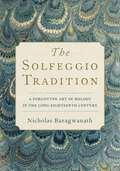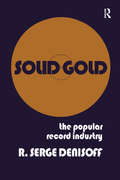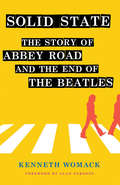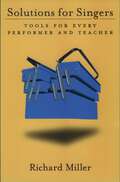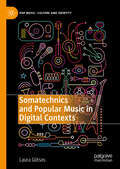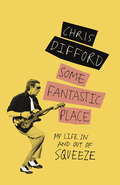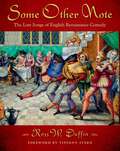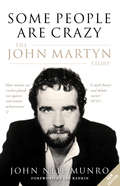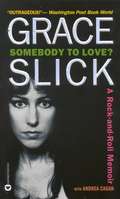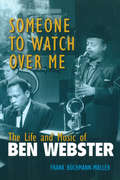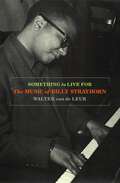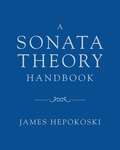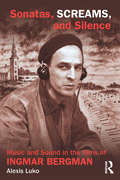- Table View
- List View
Sociology for Music Teachers: Practical Applications
by Gareth Dylan Smith Hildegard FroehlichSociology for Music Teachers: Practical Applications, Second Edition, outlines the basic concepts relevant to understanding music teaching and learning from a sociological perspective. It demonstrates the relationship of music to education, schooling and society, and examines the consequences for making instructional choices in teaching methods and repertoire selection. The authors look at major theories, and concepts relevant to music education, texts in the sociology of music, and thoughts of selected ethnomusicologists and sociologists. The new edition takes a more global approach than was the case in the first edition and includes the application of sociological theory to contexts beyond the classroom. The Second Edition: Presents major theories in ethnomusicology, both traditional and contemporary. Takes a global approach by presenting a variety of teaching practices beyond those found in the United States. Emphasizes music education in a traditional classroom setting, but also applies specific constructs to studio teaching situations in conservatories (with private lessons) and community music. Provides recommendations for teaching practices by addressing popular music in school music curricula, suggests inclusionary projects that explore musical styles and repertoire of the past and present, and connects school to community music practices of varying kinds. Contains an increased number of suggestions for projects and discussions among the students using the book.
The Sociology of Wind Bands: Amateur Music Between Cultural Domination and Autonomy (Ashgate Popular and Folk Music Series)
by Vincent Dubois Jean-Matthieu Méon translated by BartDespite the musical and social roles they play in many parts of the world, wind bands have not attracted much interest from sociologists. The Sociology of Wind Bands seeks to fill this gap in research by providing a sociological account of this musical universe as it stands now. Based on a qualitative and quantitative survey conducted in northeastern France, the authors present a vivid description of the orchestras, the backgrounds and practices of their musicians, and the repertoires they play. Their multi-level analysis, ranging from the cultural field to the wind music subfield and to everyday life relationships within bands and local communities, sheds new light on the social organisation, meanings and functions of a type of music that is all too often taken for granted. Yet they go further than merely portraying a musical genre. As wind music is routinely neglected and socially defined in terms of its poor musical quality or even bad taste, the book addresses the thorny issue of the effects of cultural hierarchy and domination. It proposes an imaginative and balanced framework which, beyond the specific case of wind music, is an innovative contribution to the sociology of lowbrow culture.
The Sociology of Wind Bands: Amateur Music Between Cultural Domination and Autonomy (Ashgate Popular and Folk Music Series)
by Vincent Dubois Jean-Matthieu Méon translated by BartDespite the musical and social roles they play in many parts of the world, wind bands have not attracted much interest from sociologists. The Sociology of Wind Bands seeks to fill this gap in research by providing a sociological account of this musical universe as it stands now. Based on a qualitative and quantitative survey conducted in northeastern France, the authors present a vivid description of the orchestras, the backgrounds and practices of their musicians, and the repertoires they play. Their multi-level analysis, ranging from the cultural field to the wind music subfield and to everyday life relationships within bands and local communities, sheds new light on the social organisation, meanings and functions of a type of music that is all too often taken for granted. Yet they go further than merely portraying a musical genre. As wind music is routinely neglected and socially defined in terms of its poor musical quality or even bad taste, the book addresses the thorny issue of the effects of cultural hierarchy and domination. It proposes an imaginative and balanced framework which, beyond the specific case of wind music, is an innovative contribution to the sociology of lowbrow culture.
Soda Goes Pop: Pepsi-Cola Advertising and Popular Music (Tracking Pop)
by Joanna LoveFrom its 1939 “Nickel, Nickel” jingle to pathbreaking collaborations with Michael Jackson and Madonna to its pair of X Factor commercials in 2011 and 2012, Pepsi-Cola has played a leading role in drawing the American pop music industry into a synergetic relationship with advertising. This idea has been copied successfully by countless other brands over the years, and such commercial collaboration is commonplace today—but how did we get here? How and why have pop music aesthetics been co-opted to benefit corporate branding? What effect have Pepsi’s music marketing practices in particular had on other brands, the advertising industry, and popular music itself? Soda Goes Pop investigates these and other vital questions around the evolving relationships between popular music and corporate advertising. Joanna K. Love joins musical analysis, historical research, and cultural theory to trace parallel shifts in these industries over eight decades. In addition to scholarly and industry resources, she draws on first-hand accounts, pop culture magazines, trade press journals, and other archival materials. Pepsi’s longevity as an influential American brand, its legendary commercials, and its pioneering, relentless pursuit of alliances with American musical stars makes the brand a particularly instructive point of focus. Several of the company’s most famous ad campaigns are prime examples of the practice of redaction, whereby marketers select, censor, and restructure musical texts to fit commercial contexts in ways that revise their aesthetic meanings and serve corporate aims. Ultimately, Love demonstrates how Pepsi’s marketing has historically appropriated and altered images of pop icons and the meanings of hit songs, and how these commercials shaped relationships between the American music business, the advertising industry, and corporate brands. Soda Goes Pop is a rich resource for scholars and students of American studies, popular culture, advertising, broadcast media, and musicology. It is also an accessible and informative book for the general reader, as Love’s musical and theoretical analyses are clearly presented for non-specialist audiences and readers with varying degrees of musical knowledge.
Solfege and Sonority: Teaching Music Reading in the Choral Classroom
by David J. XiquesSolfege and Sonority is a guide for teaching music literacy in a choral rehearsal, with a focus on the needs of teachers who work with young singers. The book lays out teaching sequences for melodic and rhythmic concepts, lesson plans, and concise strategies for introducing key techniques. The individual lessons themselves are short (no more than 4-6 minutes each) and comprehensive, encouraging singers to develop a literacy of rhythm and melody together. In 18 easy-to-use lessons for teachers and conductors and tying the lessons to the teacher's current repertoire, longtime choral director and teacher David J. Xiques has created a practical and viable solution to the challenges of many conductors, as well as providing a much-needed manual for upper-level choral pedagogy courses. The comprehensive companion website provides access to videos of exercises, worksheets, and teaching materials.
Solfege and Sonority: Teaching Music Reading in the Choral Classroom
by David J. XiquesSolfege and Sonority is a guide for teaching music literacy in a choral rehearsal, with a focus on the needs of teachers who work with young singers. The book lays out teaching sequences for melodic and rhythmic concepts, lesson plans, and concise strategies for introducing key techniques. The individual lessons themselves are short (no more than 4-6 minutes each) and comprehensive, encouraging singers to develop a literacy of rhythm and melody together. In 18 easy-to-use lessons for teachers and conductors and tying the lessons to the teacher's current repertoire, longtime choral director and teacher David J. Xiques has created a practical and viable solution to the challenges of many conductors, as well as providing a much-needed manual for upper-level choral pedagogy courses. The comprehensive companion website provides access to videos of exercises, worksheets, and teaching materials.
The Solfeggio Tradition: A Forgotten Art of Melody in the Long Eighteenth Century
by Nicholas BaragwanathHow did castrati manage to amaze their eighteenth-century audiences by singing the same aria several times in completely different ways? And how could composers of the time write operas in a matter of days? The secret lies in the solfeggio tradition, a music education method that was fundamental to the training of European musicians between 1680 and 1830 a time during which professional musicians belonged to the working class. As disadvantaged children in orphanages learned the musical craft through solfeggio lessons, many were lifted from poverty, and the most successful were propelled to extraordinary heights of fame and fortune. In this first book on the solfeggio tradition, author Nicholas Baragwanath draws on over a thousand manuscript sources to reconstruct how professionals became skilled performers and composers who could invent and modify melodies at will. By introducing some of the simplest exercises in scales, leaps, and cadences that apprentices would have encountered, this book allows readers to retrace the steps of solfeggio training and learn to generate melody by 'speaking' it like an eighteenth-century musician. As it takes readers on a fascinating journey through the fundamentals of music education in the eighteenth century, this book uncovers a forgotten art of melody that revolutionizes our understanding of the history of music pedagogy.
The Solfeggio Tradition: A Forgotten Art of Melody in the Long Eighteenth Century
by Nicholas BaragwanathHow did castrati manage to amaze their eighteenth-century audiences by singing the same aria several times in completely different ways? And how could composers of the time write operas in a matter of days? The secret lies in the solfeggio tradition, a music education method that was fundamental to the training of European musicians between 1680 and 1830 a time during which professional musicians belonged to the working class. As disadvantaged children in orphanages learned the musical craft through solfeggio lessons, many were lifted from poverty, and the most successful were propelled to extraordinary heights of fame and fortune. In this first book on the solfeggio tradition, author Nicholas Baragwanath draws on over a thousand manuscript sources to reconstruct how professionals became skilled performers and composers who could invent and modify melodies at will. By introducing some of the simplest exercises in scales, leaps, and cadences that apprentices would have encountered, this book allows readers to retrace the steps of solfeggio training and learn to generate melody by 'speaking' it like an eighteenth-century musician. As it takes readers on a fascinating journey through the fundamentals of music education in the eighteenth century, this book uncovers a forgotten art of melody that revolutionizes our understanding of the history of music pedagogy.
Solid Gold: Popular Record Industry
by R. Serge DenisoffMore than 90 record companies release over 9,000 pop records each year-a staggering total of 52,000 songs. Each one competes for the gold record, the recording industry's symbol of success that certifies $1 million worth of records have been sold. Solid Gold explains why, for each record that succeeds, countless others fail. This book follows the progress of a record through production, marketing, and distribution, and shows how a mistake made at any point can mean its doom. Denisoff suggests that a drastic shift in the demographic makeup of the pop music audience during the sixties has resulted in a broader listening public, including fans at every level of society.
Solid Gold: Popular Record Industry
by R. Serge DenisoffMore than 90 record companies release over 9,000 pop records each year-a staggering total of 52,000 songs. Each one competes for the gold record, the recording industry's symbol of success that certifies $1 million worth of records have been sold. Solid Gold explains why, for each record that succeeds, countless others fail. This book follows the progress of a record through production, marketing, and distribution, and shows how a mistake made at any point can mean its doom. Denisoff suggests that a drastic shift in the demographic makeup of the pop music audience during the sixties has resulted in a broader listening public, including fans at every level of society.
Solid State: The Story of "Abbey Road" and the End of the Beatles
by Kenneth WomackAcclaimed Beatles historian Kenneth Womack offers the most definitive account yet of the writing, recording, mixing, and reception of Abbey Road.In February 1969, the Beatles began working on what became their final album together. Abbey Road introduced a number of new techniques and technologies to the Beatles' sound, and included "Come Together," "Something," and "Here Comes the Sun," which all emerged as classics. Womack's colorful retelling of how this landmark album was written and recorded is a treat for fans of the Beatles. Solid State takes readers back to 1969 and into EMI's Abbey Road Studio, which boasted an advanced solid state transistor mixing desk. Womack focuses on the dynamics between John, Paul, George, Ringo, and producer George Martin and his team of engineers, who set aside (for the most part) the tensions and conflicts that had arisen on previous albums to create a work with an innovative (and, among some fans and critics, controversial) studio-bound sound that prominently included the new Moog synthesizer, among other novelties. As Womack shows, Abbey Road was the culmination of the instrumental skills, recording equipment, and artistic vision that the band and George Martin had developed since their early days in the same studio seven years earlier. A testament to the group's creativity and their producer's ingenuity, Solid State is required reading for all fans of the Beatles and the history of rock 'n' roll.
Solo Keyboard Works: Franz Seydelmann (Music Archive Publications)
by Bernard BauchiliFirst Published in 1997. Born in Dresden Germany, in 1748 Franz Seydelmann was an active music composer. He is principally known for his operas and church music, however he also wrote twenty-three sonatas, including seven solo harpischord sonatas, a Capriccio with variations and the Six Sonatas for Two Persons at Keyboard.
Solo Keyboard Works: Franz Seydelmann (Music Archive Publications #Vol. 1)
by Franz Seydelmann; Bernard BrauchliFirst Published in 1997. Born in Dresden Germany, in 1748 Franz Seydelmann was an active music composer. He is principally known for his operas and church music, however he also wrote twenty-three sonatas, including seven solo harpischord sonatas, a Capriccio with variations and the Six Sonatas for Two Persons at Keyboard.
Solutions for Singers: Tools for Performers and Teachers
by Richard MillerWhile many texts and courses on the art of singing offer comprehensive overviews of technique and performance, few have time to delve into the specific questions they spawn. Solutions for Singers explores these unanswered questions, filling in gaps that professional performers, students of singing, and voice teachers have long sought to close. Fielding over 200 questions, distinguished teacher and performer Richard Miller tackles problems raised during hundreds of his master classes and pedagogy courses. He deliberately avoids abstract generalities, concentrating instead on specific, recurring questions: What are some good exercises to loosen or relax tension in the back of the tongue? Do you apply the same principles regarding breathing to a younger student that you do to older students? What is meant by voiced and unvoiced consonants? Is there a female falsetto? Through such specialized questions, Miller probes the very essence of artistic expression. The questions are organized under ten broad topics, which Miller considers from various angles. He couples traditional and modern philosophies to present the most relevant and precise solutions. The result is an invaluable handbook for singers, which, read either sequentially or selectively, provides a unique and pragmatic approach to vocal artistry and technique.
Solutions for Singers: Tools for Performers and Teachers
by Richard MillerWhile many texts and courses on the art of singing offer comprehensive overviews of technique and performance, few have time to delve into the specific questions they spawn. Solutions for Singers explores these unanswered questions, filling in gaps that professional performers, students of singing, and voice teachers have long sought to close. Fielding over 200 questions, distinguished teacher and performer Richard Miller tackles problems raised during hundreds of his master classes and pedagogy courses. He deliberately avoids abstract generalities, concentrating instead on specific, recurring questions: What are some good exercises to loosen or relax tension in the back of the tongue? Do you apply the same principles regarding breathing to a younger student that you do to older students? What is meant by voiced and unvoiced consonants? Is there a female falsetto? Through such specialized questions, Miller probes the very essence of artistic expression. The questions are organized under ten broad topics, which Miller considers from various angles. He couples traditional and modern philosophies to present the most relevant and precise solutions. The result is an invaluable handbook for singers, which, read either sequentially or selectively, provides a unique and pragmatic approach to vocal artistry and technique.
Somatechnics and Popular Music in Digital Contexts (Pop Music, Culture and Identity)
by Laura GlitsosThis book is a celebration and explication of the body in the world and the ways that our body situates our consciousness as a lived formation, one which is oriented by the experience of music listening. The book examines the relationship between bodies, technics, and music, using the theoretical tools of somatechnics. Somatechnics calls for a recognition of the body in the world as an artefact wrapped up, entangled and produced by the materialities of that world. It traverses discussions on materiality, live music, touchscreen media, the personal computer, and new modes of listening such as virtual reality technologies. Finally, the book looks at music itself as a kind of technology that generates new modes of bodily being.
Some Fantastic Place: My Life In and Out of Squeeze
by Chris DiffordLonglisted for the Penderyn Music Book PrizeOver the course of a thirteen-album and multi-award-winning career with Squeeze, it was clear from the very beginning that Chris Difford has few peers when it comes to smart, pithy lyricism. In Some Fantastic Place, he charts his life from his childhood in south London to becoming a member of one of Britain's greatest bands and beyond. Along the way Chris reveals the inspiration and stories behind Squeeze's best-known songs, and his greatest highs and lows from over four decades of making music.
Some Other Note: The Lost Songs of English Renaissance Comedy
by Ross W. DuffinEnglish comedy from the fifteenth to the early seventeenth century abounds in song lyrics, but most of the original tunes were thought to have been lost--until now. By deducing that playwrights borrowed melodies from songs they already knew, Ross W. Duffin has used the existing English repertory of songs, both popular and composed, to reconstruct hundreds of songs from more than a hundred plays and other stage entertainments. Thanks to Duffin's incredible breakthrough, these plays have been rendered performable with period music for the first time in five hundred years. Some Other Note not only brings these songs back from the dead, but tells a thrilling tale of the investigations that unraveled these centuries-old mysteries.
Some Other Note: The Lost Songs of English Renaissance Comedy
by Ross W. DuffinEnglish comedy from the fifteenth to the early seventeenth century abounds in song lyrics, but most of the original tunes were thought to have been lost--until now. By deducing that playwrights borrowed melodies from songs they already knew, Ross W. Duffin has used the existing English repertory of songs, both popular and composed, to reconstruct hundreds of songs from more than a hundred plays and other stage entertainments. Thanks to Duffin's incredible breakthrough, these plays have been rendered performable with period music for the first time in five hundred years. Some Other Note not only brings these songs back from the dead, but tells a thrilling tale of the investigations that unraveled these centuries-old mysteries.
Some People Are Crazy: The John Martyn Story
by John Neil MunroDescribed recently by Empire magazine as 'Britain's best ever blues singer', John Martyn was one of rock music's last real mavericks. Despite long-term addiction to alcohol and drugs, which contributed to his death in January 2009, he produced a string of matchless albums. Loved by fans and critics, loathed by ex-managers, he survived the music business he despised for 40 years. With contributions by Martyn, many of his lovers and over 20 musicians who knew him well, this book documents his upbringing in Glasgow and rise through the Scottish and London folk scene of the 1960s, his many highs and lows, and his friendships with the great lost souls of British rock music - Nick Drake and Paul Kossoff.
Somebody to Love?: A Rock-and-Roll Memoir
by Grace Slick Andrea CaganA candid autobiography of the great rock diva of Jefferson Airplane and Jefferson Starship, revealing her wild life at the forefront of the Sixties and Seventies counterculture.She has been called rock and roll's original female outlaw, as famous for her bad behavior as for her haunting singing voice. In her 25-year career as a musician, Grace Slick charted dozens of hits and sold millions of albums. From "White Rabbit" and "Somebody to Love" to "Sarah" and "Miracles", the songs she performed became the anthems of a generation.Whether describing her antics at the White House with Abbie Hoffman or the unforgettable experience that was Woodstock, Slick's recollections have the same rich imagery found in her lyrics. In this provocative narrative, readers will discover the many sides of Grace Slick: as artistic pioneer; she records songs with Jerry Garcia and David Crosby; as practitioner of freedom and rebellion; she sleeps with Jim Morrison and gets arrested for DUI on three separate occasions (without actually being in a car); and as a loving mother to actress China Kantner, she tries to balance casual friendship with parental wisdom.Slick offers a revealing self-portrait of the complex woman behind the rock-outlaw image, and delivers a behind-the-scenes, no-holds-barred view of the people and spirit that defined a quarter-century of American pop culture. Wildly funny, candid, and evocative, Somebody to Love?tells what it was really like during, and after, the Summer of Love-and how one remarkable woman survived it all to remain today as vibrant and rebellious as ever.
Someone to Watch Over Me: The Life and Music of Ben Webster (Jazz Perspectives)
by Frank Büchmann-MøllerFor a half century, Ben Webster, one of the "big three" of swing tenors-along with Coleman Hawkins and Lester Young-was one of the best-known and most popular saxophonists. Early in his career, Webster worked with many of the greatest orchestras of the time, including those led by Willie Bryant, Cab Calloway, Benny Carter, Fletcher Henderson, Andy Kirk, Bennie Moten, and Teddy Wilson. In 1940 Webster became Duke Ellington's first major tenor soloist, and during the next three years he played on many famous recordings, including "Cotton Tail." Someone to Watch Over Me tells, for the first time, the complete story of Ben Webster's brilliant and troubled career. For this comprehensive study of Webster, author Frank Büchmann-Møller interviewed more than fifty people in the United States and Europe, and he includes numerous translated excerpts from European periodicals and newspapers, none previously available in English. In addition, the author studies every known Webster recording and film, including many private recordings from Webster's home collection not available to the public. Exhaustively researched, this is a much needed and long overdue study of the life and music of one of jazz's most important artists.
Something to Live For: The Music of Billy Strayhorn
by Walter van de LeurDuke Ellington was one of jazz's greatest figures, a composer and bandleader of unparalleled importance and influence. But little attention has been given to his chief musical collaborator, Billy Strayhorn, who created hundreds of compositions and arrangements for his musical partner, and without whom the sound of Ellington's orchestra would have been very different. Now, in Walter van de Leur's provocative new book, Something To Live For, Billy Strayhorn steps out from Ellington's shadow and into the spotlight. Van de Leur argues that far from being merely a follower of Ellington or his alter ego, Strayhorn brought a radically new and visionary way of writing to the Ellington orchestra. Making extensive use, for the first time, of over 3,000 autograph scores, Van de Leur separates Strayhorn from Ellington, establishes who wrote what, and clearly distinguishes between their distinctive musical styles. "Both Strayhorn's and Ellington's oeuvres," writes Van de Leur, "though historically intertwined, nevertheless form coherent, separate musical entities, especially in terms of harmonic, melodic, and structural design." Indeed, Something to Live For allows us to see the characteristic features of Strayhorn's compositions and arrangements, his "musical fingerprints," and to analyze and evaluate his music on its own terms. The book also makes clear that Strayhorn's contribution to the band was much larger, and more original, than has been previously acknowledged. Based on a decade of research and offering detailed analyses of over 70 musical examples, Something to Live For casts new light--and will surely arouse intense debate--on two of the most important composers in the history of jazz.
A Sonata Theory Handbook
by James HepokoskiSonata form is the most commonly encountered organizational plan in the works of the classical-music masters, from Haydn, Mozart, and Beethoven to Schubert, Brahms, and beyond. Sonata Theory, an analytic approach developed by James Hepokoski and Warren Darcy in their award-winning Elements of Sonata Theory (2006), has emerged as one of the most influential frameworks for understanding this musical structure. What can this method from "the new Formenlehre" teach us about how these composers put together their most iconic pieces and to what expressive ends? In this new Sonata Theory Handbook, Hepokoski introduces readers step-by-step to the main ideas of this approach. At the heart of the book are close readings of eight individual movements from Mozart's Piano Sonata in B-flat, K. 333, to such structurally complex pieces as Schubert's "Death and the Maiden" String Quartet and the finale of Brahms's Symphony No 1 that show this analytical method in action. These illustrative analyses are supplemented with four updated discussions of the foundational concepts behind the theory, including dialogic form, expositional action zones, trajectories toward generically normative cadences, rotation theory, and the five sonata types. With its detailed examples and deep engagements with recent developments in form theory, schema theory, and cognitive research, this handbook updates and advances Sonata Theory and confirms its status as a key lens for analyzing sonata form.
Sonatas, Screams, and Silence: Music and Sound in the Films of Ingmar Bergman
by Alexis LukoSonatas, Screams, and Silence: Music and Sound in the Films of Ingmar Bergman is the first musical examination of Bergman’s style as an auteur filmmaker. It provides a comprehensive examination of all three aspects (music, sound effects, and voice) of Bergman’s signature soundtrack-style. Through examinations of Bergman’s biographical links to music, the role of music, sound effects, silence, and voice, and Bergman’s working methods with sound technicians, mixers, and editors, this book argues that Bergman’s soundtracks are as superbly developed as his psychological narratives and breathtaking cinematography. Interdisciplinary in nature, this book bridges the fields of music, sound, and film.
